|
|
|
Sort Order |
|
|
|
Items / Page
|
|
|
|
|
|
|
| Srl | Item |
| 1 |
ID:
175707


|
|
|
|
|
| Summary/Abstract |
As a speech act, takfir—the allegation of a Muslim’s apostasy—may insinuate violence in a way that can delimit the boundaries of political, as well as religious, community. Yet the use of takfir also incurs costs in plural political environments. Those who engage in it do not always see the dividends they may imagine. This article compares public acts of takfir at critical moments in Tunisia and Yemen to argue that the weight of this particular idiom is not universal, but is a function of the specific linguistic field in which it is employed as well as the historical juncture in which it takes place. Takfir both shapes and reflects the power relations between rival factions. As an informal discourse that occurs largely outside of formal state institutions, it nonetheless leaves a clear imprint on those institutions, particularly in moments of political transition when the contours of new constitutional arrangements are negotiated. Relying on ethnographic and interview-based field research from both Tunisia and Yemen, the context-specific arguments advanced here challenge the universalist prescriptions that underwrite policy efforts to engage in “counter-takfir” as a means of combatting excommunicative discourse.
|
|
|
|
|
|
|
|
|
|
|
|
|
|
|
|
| 2 |
ID:
175713
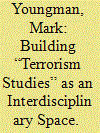

|
|
|
|
|
| Summary/Abstract |
Over the years, there have been many debates regarding the state of research into terrorism and whether “terrorism studies” constitutes an academic discipline in its own right. Such reflections, coupled with the natural evolution of what is still a relatively new area of research, have arguably led to significant improvements in quality and rigour. At the same time, the status of terrorism studies itself remains somewhat ambiguous: it is both discussed as a distinct field and simultaneously evades criticism by pointing to the difficulties of defining its boundaries. There are undoubtedly a number of advantages to forming a separate discipline, which would go some way to helping the field address some of the recurring problems that terrorism research faces. However, this article ultimately argues that scholars are better served by deliberately moving in the other direction and developing the field as a space for interdisciplinary engagement.
|
|
|
|
|
|
|
|
|
|
|
|
|
|
|
|
| 3 |
ID:
175714
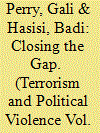

|
|
|
|
|
| Summary/Abstract |
In the aftermath of 9/11, aviation security has become a central component of counterterrorism. To mitigate threats whilst maintaining flight schedules, airport security officers require the cooperation of all passengers, but especially of ethnic minorities perceived as posing a potential threat to homeland security, often referred to as “suspect communities.” Passengers from suspect communities are subject to rigorous screening, but are also regarded as a source of information, making their cooperation even more important than that of other passengers. Nevertheless, suspect communities’ cooperation with airport security, and the gap between their attitudes and those of other passengers, have not yet been examined. The current study utilizes a survey of 1970 passengers at the Ben-Gurion airport in Israel, examining passengers’ perceptions of airport security and their willingness to cooperate. We find that passengers belonging to the suspect community of Israeli Muslims were less willing to cooperate with security procedures than all other passengers. However, when controlling for passengers’ perceptions of legitimacy and procedural justice, Israeli Muslims were more willing to cooperate with airport security than Israeli Jews. The findings highlight the importance of legitimacy and procedural justice perceptions in obtaining the cooperation of suspect communities, and suggest practical pathways for improving cooperation.
|
|
|
|
|
|
|
|
|
|
|
|
|
|
|
|
| 4 |
ID:
175720
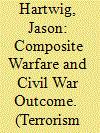

|
|
|
|
|
| Summary/Abstract |
Can rebels utilize variation in modes of warfare to overcome long odds and defeat incumbent forces? I find that rebel use of hybrid forms of warfare – the alternating use of conventional and irregular warfare – produce remarkably higher rates of victory over rebellions utilizing only irregular or conventional warfare. I argue that specific structural and organizational conditions enable use of hybrid warfare. Access to sanctuary, centralized command, and social-political cohesion interact with one another to create remarkably flexible and durable rebel organizations capable of absorbing conventional defeats, while using irregular warfare to shape conditions for eventual conventional victory.
|
|
|
|
|
|
|
|
|
|
|
|
|
|
|
|
| 5 |
ID:
175746


|
|
|
|
|
| Summary/Abstract |
Despite a pervasive concern among law enforcement and security agencies, there are relatively few academic explorations of the likelihood of violence associated with anti-authority activists from groups such as the Freemen-on-the-Land, Sovereign Citizens, and similar movements within Canada. In order to begin addressing this gap in knowledge, this article uses a multi-method approach to explore and assess the potential for violence by the Canadian anti-authority community against the state in particular. Data were gathered from interviews with law enforcement, lawyers, judges, notaries, and movement adherents (n = 32), as well as from the analysis of open source data which included media reports, court documents, and movement websites. Results suggest that there are three distinct classes of violent activity, directed specifically at the state and state actors, that are prevalent among Canadian anti-authority movements: a) offensive/extremist violence; b) defensive/reactionary violence; and c) harassment and intimidation. The article concludes with a discussion of two emerging areas of concern related to Canadian anti-authority violence and responses to the anti-authority community in Canada.
|
|
|
|
|
|
|
|
|
|
|
|
|
|
|
|
| 6 |
ID:
175744
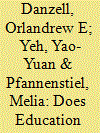

|
|
|
|
|
| Summary/Abstract |
Policymakers often tout expanded access to education as an antidote for terrorism in Africa. Targeted economic development is also considered a necessary complement to education gains because young, well-educated individuals who lack viable opportunities are vulnerable targets of radicalization. Despite common assertions that poor socioeconomic circumstances drive radicalization, empirical research has hitherto neglected critical inquiry of these policies. Varied findings across cross-national studies of education expansion and the effects of burgeoning youth cohorts warrant a focused examination of regions plagued by the proliferation of extremist groups. This study explores the role of education in mitigating a turn to terror among youth in Africa by examining 50 countries from 1970 to 2011. Expansions in primary, secondary, and tertiary education appear to have different influences on domestic terrorism. In the sub-Saharan region, one model shows primary and secondary education reduced terrorism while others indicate non-monotonic effects in societies experiencing a youth bulge. These nuanced findings suggest education should not be relied upon to counter extremism without additional initiatives to facilitate socioeconomic opportunities. The implication of this paper’s findings are important for academics and policymakers eager to create stable polities across the African continent.
|
|
|
|
|
|
|
|
|
|
|
|
|
|
|
|
| 7 |
ID:
175708
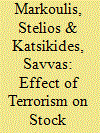

|
|
|
|
|
| Summary/Abstract |
This paper examines the relationship between terrorist attacks and stock market performance, by employing the “event-study” methodology to examine eleven major terrorist attacks that occurred in the 21st century. Results suggest that earlier events appear to result in higher negative abnormal returns when compared to more recent ones. Where evident, these abnormal returns seem to persist beyond the date of the event, but tend to disappear rather quickly. Some events appear to exhibit a “spill-over” effect influencing international stock markets too. Our most important finding is that recent events do not seem to influence local or international markets, thus suggesting that investors have learnt to better assess terror events and react more calmly to them.
|
|
|
|
|
|
|
|
|
|
|
|
|
|
|
|
| 8 |
ID:
175704
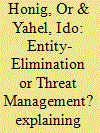

|
|
|
|
|
| Summary/Abstract |
Israel’s policy towards both terrorist semi-states (TSS)—Fatahland and Hamas-controlled Gaza—shows a puzzling variation over time between threat-management (i.e., deterrence and/or brute force capacity-reduction) and entity-elimination. We hold that a military-based cost-benefit analysis cannot fully account for this variation. This explanation predicts that Israel would avoid the costly and risky TSS-elimination as long as Israel can effectively manage the military danger through the much cheaper deterrence/periodical capacity reduction or when there is a high risk of not getting a much better option partly due to the danger of creating a power-vacuum into which other terrorists may reenter. Yet, some Israeli Prime Ministers pursued TSS-elimination notwithstanding the vacuum consideration and deterrence working. By adding a non-military variable—the extent to which Israel’s policy-makers believe that the TSS harms their ideologically-preferred foreign policy goals—we can better reconstruct changes in threat perception and hence better explain policy variation. The TSSs became an intolerable danger only when non-military threats were involved. Israel was willing to tolerate TSSs when the Prime Minister believed they did not pose a political/ideological threat but sought to eliminate them when he thought they did, if there seemed to be a feasible alternative.
|
|
|
|
|
|
|
|
|
|
|
|
|
|
|
|
| 9 |
ID:
175732


|
|
|
|
|
| Summary/Abstract |
Women’s radicalization is a pending issue in empirical research that is worthy of attention. It has been found that the role of women in international terrorism is much greater than previously thought, but we know almost nothing about the factors underlying the process that would lead them to perpetrate radicalized acts, as almost no empirical research has been carried out on the subject. In this work we aim to explore a model of radicalization of thought and action among young women. The hypothesized model included ten predictors: cultural identity, cultural discrimination, religious involvement, depressive symptoms, and schizotypal, borderline, and the Dark Tetrad traits of personality. Dogmatism was hypothesized as a mediator between these factors and the level of radicalized cognitions and behaviors. The sample comprises 643 college women (aged 18 to 29) from French universities. Our results suggest that women becoming involved in radicalization are more “dark” than “disturbed.” Schizotypal, borderline, and depressive features, although being associated to radicalization, do not contribute to the model. Both the dark traits and socio-cultural factors are revealed as predictors of radicalization, while dogmatism is clearly shown as a mediator. Orientations in terms of prevention among young women are proposed.
|
|
|
|
|
|
|
|
|
|
|
|
|
|
|
|
| 10 |
ID:
175705
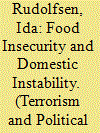

|
|
|
|
|
| Summary/Abstract |
Research on the relationship between food insecurity and unrest has a long history. The food price spikes in 2007–2008 and 2010–2011 coincided with demonstrations and incidents of large-scale violence, prompting renewed scholarly interest in the link between food insecurity and unrest. This paper reviews the literature, synthesises its main empirical findings and central explanations, and identifies four particular issues to consider to enhance our understanding of how food insecurity is related to unrest. First, there is a wide range of suggested theoretical mechanisms of how food insecurity is linked to unrest, but the empirical tests are akin. Second, there exist various notions of the independent variable, but there is a gap between the theoretical definition and measurement. Third, the focus is often on “food riots”, but whether rioting is the most likely response, and whether it is possible to separate between “food-related” unrest and other types of turmoil is unclear. Lastly, there is a challenge to address the endogenous nature of food insecurity and unrest. The paper adds to the literature by pointing to the theoretical mechanisms linking food insecurity to unrest, relating both to the type and degree of food insecurity, and how we understand and define unrest.
|
|
|
|
|
|
|
|
|
|
|
|
|
|
|
|
| 11 |
ID:
175736


|
|
|
|
|
| Summary/Abstract |
This article builds a new theoretical framework to understand the role of threats in terrorism. Interviews of IRA members give rise to a speech/kinetic action model of terrorism, in which threats and violence jointly determine the physical consequences and political messages conveyed by terrorist attacks. In fact, threats are integral to the attack, and some attacks can be said to consist of threats alone. IRA interviews reveal four varieties of threats: warnings, hoaxes, pledges, and bluffs. These categories are distinguished by the timing of the threatened violence (immediate or prospective) and the intended truthfulness of the threat. The IRA interviews establish the function of each type of threat in influencing the beliefs or behavior of state and society. Threats may disrupt the economy, increase or decrease bloodshed, control social behavior, secure tactical or strategic advantage, claim attacks, aggrandize the perpetrator, and facilitate bargaining. A single threat may serve several of these functions, signaling different messages to different audiences. In fact, this is one of the most important applications of threats. When violence alone would produce suboptimal outcomes, threats alter the pattern of damage in a way that optimizes militants’ messaging for all audiences.
|
|
|
|
|
|
|
|
|
|
|
|
|
|
|
|
| 12 |
ID:
175739
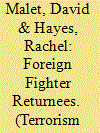

|
|
|
|
|
| Summary/Abstract |
How long does it typically take a returned foreign fighter to launch a domestic terror attack? The issue of returnees, and appropriate national and international responses to potential threats, has become a preeminent security concern of the 2010s, impacting policies on everything from refugees to whether to permit ISIS fighters to leave the theater of conflict alive. This article attempts to illuminate these contentious debates through a new data set of Lags in Attack Times of Extremist Returnees (LATER) that examines 230 jihadi returnees to Western countries. The data indicate that the majority of attempted attacks occur within one year, with a median lag time of just four months. Prison appears to play no role in lag times. Our findings indicate that security and reintegration efforts should be targeted within the critical six months after return, which diminishes the risk of attack considerably.
|
|
|
|
|
|
|
|
|
|
|
|
|
|
|
|
| 13 |
ID:
175716
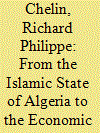

|
|
|
|
|
| Summary/Abstract |
Al Qaeda in the Islamic Maghreb (AQIM) appeared on the Algerian landscape in 2007 after the merger between Al Qaeda and the GSPC, with the objective of expanding its existing network in North Africa and the Sahel region. Pressure from security forces in Algeria propelled the group to seek refuge in Mali, where the 2012 conflict provided a safe haven for the group. Opération Serval, launched by the French military in 2013, dealt a severe setback to AQIM, as many of its fighters were killed and others dispersed to other parts of the region. From that period onwards, there has been a reduction in terror attacks and bombings until recently. Yet, an increase in kidnapping of foreigners for ransom coupled with drug trafficking signalled a transformation in the modus operandi of the group. To understand this trend, the article applies the crime-terror paradigm in order to assess the evolution of AQIM from a terror group with political and religious intentions into a group engaged in criminal activities with economic motivations. The article finds that AQIM is a hybrid entity that displays both terrorist and criminal motivations which are determined by the context within which the group finds itself.
|
|
|
|
|
|
|
|
|
|
|
|
|
|
|
|
| 14 |
ID:
175740


|
|
|
|
|
| Summary/Abstract |
The study addresses the question of whether there is a global pattern of terror organization (TO) lifespan. Based on two datasets which include hundreds of organizations, we show that there is a global statistical law of TO lifespan distribution. This distribution describes populations of TOs in different contexts of periods, geographical locations, ideologies, etc. The data as a whole, as well as its subpopulations, seem to emerge from an exponential distribution, which is formulated as a mathematical model. This model enables the prediction of TOs’ global population decay rate. The findings were obtained by introducing a novel procedure, which formulates and validates this mathematical law for discrete empirical data. We suggest that human behavior generating informational cascades and a positive feedback loop, which influence the number of core members in a TO, may be the source of this global pattern.
|
|
|
|
|
|
|
|
|
|
|
|
|
|
|
|
| 15 |
ID:
175715


|
|
|
|
|
| Summary/Abstract |
In 2014 and then again in 2015-16 in Jerusalem, some Palestinians attacked Israelis and others, including through stabbings and vehicular attacks. A case study of Israeli rule of Palestinians in Jerusalem highlights the causal role of horizontal inequality or inter-group disparities in cultural, economic, political, and social realms. Palestinians are shortchanged in each realm, and this helps fuel the violence in the city. The case also adds further nuance to some of the supporting arguments put forward by scholars in the horizontal inequality tradition. Miodownik & Nir’s focus on perceptions suggests the possibility of a gap between reality and perceptions, but in East Jerusalem, Israeli policy and Palestinian perceptions appear in synch. The spontaneous grassroots violence with only limited organizational support contrasts with other cases where violence was the result of the interaction between elites influenced by political inequality and masses motivated by economic inequality. Lastly, Stewart’s policy recommendation of more aid to reduce economic inequality assumes that the rulers will provide more aid or allow others to do so. In East Jerusalem, Israel has not provided sufficient resources but also has blocked the most likely substitute, the Palestinian Authority, from freely operating in East Jerusalem.
|
|
|
|
|
|
|
|
|
|
|
|
|
|
|
|
| 16 |
ID:
175734
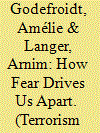

|
|
|
|
|
| Summary/Abstract |
A central aim of terrorism is to drive people apart and destroy social trust. Still, there is little empirical research which has systematically investigated the relationship between terrorist attacks, fear of terrorism, and social trust. In addition, the impact of terrorism is usually assumed to be uniform across different individuals and societies. In order to investigate the impact of terrorism as well as the fear of future terrorism on trust levels of different types of individuals and societies, we combine individual-level survey data of the most recent World Values Survey (WVS, Round 6, 2010–2014) with several indicators at the country-level. Our findings show that social trust is principally damaged by the fear of future terrorist attacks, more so than by past terrorist attacks. Moreover, this deleterious impact of the fear of terrorism on social trust is most prevalent in more democratic countries and among individuals who are more frequently exposed to television news. Hence, with relatively limited capabilities and resources, terrorists may therefore evoke disproportionate fear effects within democratic societies which are, at least partially, fueled by media exposure.
|
|
|
|
|
|
|
|
|
|
|
|
|
|
|
|
| 17 |
ID:
175735
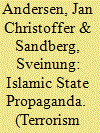

|
|
|
|
|
| Summary/Abstract |
The Islamic State (IS) has become notorious for violent, brutal actions and the presentation of these actions in social and mainstream media. Excessive violence creates a spectacle for the news media. However, IS propaganda also emphasizes its role in state building and its engagement in social and welfare work. This twofold propaganda enables the mobilization of different audiences, but it also sends conflicting messages about the organization. In this article, we study the e-magazine Dabiq, emphasizing its methods of gaining support and attempting to recruit Western participants to violent jihadism. We use theories of social movement and subculture to reveal some of the underlying tensions in IS’s communicative strategies. The analysis first identifies how IS frames its propaganda, attempting to mobilize widespread support. Then, it highlights another dimension of IS’s rhetoric: provocations, the creation of sensationalist spectacles of violence and links to excitement seeking, stardom, and popular culture. We conclude that combining general anti-Western rhetoric and religious imagery with extraordinary depictions of violence has been both a strength and flaw in the organization’s propaganda.
|
|
|
|
|
|
|
|
|
|
|
|
|
|
|
|
| 18 |
ID:
175724
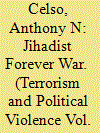

|
|
|
|
|
| Summary/Abstract |
It has been over a year since the last vestige of Islamic State of Iraq and al-Sham’s (ISIS) caliphate project in the town of Baghuz was captured by American-backed Syrian-Kurdish paramilitary forces. 1 A culmination of four years of bloody warfare between an international coalition of sixty plus nations and ISIS’s global terror network whose size and endurance proved difficult to overcome. Despite the death of some tens of thousands of its fighters and the loss of its transnational state, ISIS remains a potent insurgent-terror movement.
|
|
|
|
|
|
|
|
|
|
|
|
|
|
|
|
| 19 |
ID:
175731


|
|
|
|
|
| Summary/Abstract |
Although there has recently been a considerable increase in research into lone actor terrorism, one of the main areas that remains understudied is that of target selection. The lack of empirically driven studies that can guide prevention measures is a notable oversight. This paper applies methods from environmental criminology to examine the residence-to-attack journeys of 122 lone terrorist acts in the U.S and Europe. The distance decay effect was evident, and significant differences were found between subgroups. Individuals were more likely to travel further if a) they were in the U.S, b) they had links to a wider network, c) they had a single-issue ideology, d) they attacked an iconic target, e) they attacked a symbolic building, or f) they used a bomb as their main weapon. A few case studies are discussed which highlight a need to conduct further research that considers the whole nodal network of an individual. The findings suggest that distance can be put forward as a constraining factor on lone actor target selection and provide support for the notion that the spatial decision making of terrorists is similar to traditional criminals.
|
|
|
|
|
|
|
|
|
|
|
|
|
|
|
|
| 20 |
ID:
175741


|
|
|
|
|
| Summary/Abstract |
The threat of chemical, biological, radiological and nuclear (CBRN) terrorism is widely attributed to collective actors based on a religious ideology, e.g. globally operating Salafi-jihadist groups like al-Qaeda or ISIL. Only limited attention has been given to the CBRN threat of violent domestic extremists in general or far-right terrorists specifically. Nevertheless, a number of incidents involving far-right activists and CBRN agents in Western countries are known to the public, even though these have had comparatively little impact on public threat perception. This study systematically collected public information about far-right CBRN incidents to identify their main characteristics. The authors were able to identify 31 incidents in Western countries since 1970, which display features contrary to generally assumed forms of CBRN terrorism. Far-right CBRN terrorism appears to be predominantly a lone-actor phenomenon oftentimes involving middle-aged and comparatively well-educated male perpetrators, mostly motivated by non-religious forms of far-right ideology (i.e. neo-Nazism, non-religious white supremacism) and indiscriminately targeting victims. Overall, far-right actors attempting to weaponize CBRN agents have been few and generally technically inept. However, the characteristics of the plots pose potential challenges for effective counter-measures and intervention, should the number of actors or the technical sophistication of plots increase in the future.
|
|
|
|
|
|
|
|
|
|
|
|
|
|
|
|
|
|
|
|
|